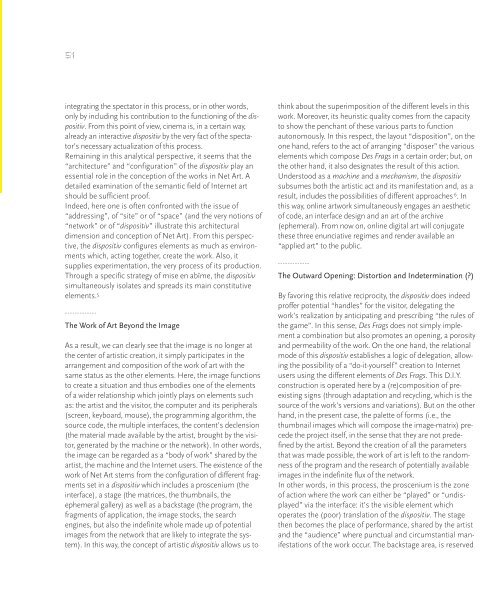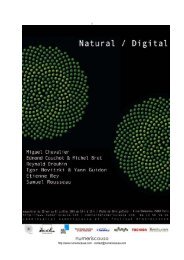Télécharger le pdf de la publication - Reynald Drouhin
Télécharger le pdf de la publication - Reynald Drouhin
Télécharger le pdf de la publication - Reynald Drouhin
Create successful ePaper yourself
Turn your PDF publications into a flip-book with our unique Google optimized e-Paper software.
51<br />
integrating the spectator in this process, or in other words,<br />
only by including his contribution to the functioning of the dispositiv.<br />
From this point of view, cinema is, in a certain way,<br />
already an interactive dispositiv by the very fact of the spectator’s<br />
necessary actualization of this process.<br />
Remaining in this analytical perspective, it seems that the<br />
“architecture” and “configuration” of the dispositiv p<strong>la</strong>y an<br />
essential ro<strong>le</strong> in the conception of the works in Net Art. A<br />
<strong>de</strong>tai<strong>le</strong>d examination of the semantic field of Internet art<br />
should be sufficient proof.<br />
In<strong>de</strong>ed, here one is often confronted with the issue of<br />
“addressing”, of “site” or of “space” (and the very notions of<br />
“network” or of “dispositiv” illustrate this architectural<br />
dimension and conception of Net Art). From this perspective,<br />
the dispositiv configures e<strong>le</strong>ments as much as environments<br />
which, acting together, create the work. Also, it<br />
supplies experimentation, the very process of its production.<br />
Through a specific strategy of mise en abîme, the dispositiv<br />
simultaneously iso<strong>la</strong>tes and spreads its main constitutive<br />
e<strong>le</strong>ments. 5<br />
...................<br />
The Work of Art Beyond the Image<br />
As a result, we can c<strong>le</strong>arly see that the image is no longer at<br />
the center of artistic creation, it simply participates in the<br />
arrangement and composition of the work of art with the<br />
same status as the other e<strong>le</strong>ments. Here, the image functions<br />
to create a situation and thus embodies one of the e<strong>le</strong>ments<br />
of a wi<strong>de</strong>r re<strong>la</strong>tionship which jointly p<strong>la</strong>ys on e<strong>le</strong>ments such<br />
as: the artist and the visitor, the computer and its peripherals<br />
(screen, keyboard, mouse), the programming algorithm, the<br />
source co<strong>de</strong>, the multip<strong>le</strong> interfaces, the content’s <strong>de</strong>c<strong>le</strong>nsion<br />
(the material ma<strong>de</strong> avai<strong>la</strong>b<strong>le</strong> by the artist, brought by the visitor,<br />
generated by the machine or the network). In other words,<br />
the image can be regar<strong>de</strong>d as a “body of work” shared by the<br />
artist, the machine and the Internet users. The existence of the<br />
work of Net Art stems from the configuration of different fragments<br />
set in a dispositiv which inclu<strong>de</strong>s a proscenium (the<br />
interface), a stage (the matrices, the thumbnails, the<br />
ephemeral gal<strong>le</strong>ry) as well as a backstage (the program, the<br />
fragments of application, the image stocks, the search<br />
engines, but also the in<strong>de</strong>finite who<strong>le</strong> ma<strong>de</strong> up of potential<br />
images from the network that are likely to integrate the system).<br />
In this way, the concept of artistic dispositiv allows us to<br />
think about the superimposition of the different <strong>le</strong>vels in this<br />
work. Moreover, its heuristic quality comes from the capacity<br />
to show the penchant of these various parts to function<br />
autonomously. In this respect, the <strong>la</strong>yout “disposition”, on the<br />
one hand, refers to the act of arranging “disposer” the various<br />
e<strong>le</strong>ments which compose Des Frags in a certain or<strong>de</strong>r; but, on<br />
the other hand, it also <strong>de</strong>signates the result of this action.<br />
Un<strong>de</strong>rstood as a machine and a mechanism, the dispositiv<br />
subsumes both the artistic act and its manifestation and, as a<br />
result, inclu<strong>de</strong>s the possibilities of different approaches 6 . In<br />
this way, online artwork simultaneously engages an aesthetic<br />
of co<strong>de</strong>, an interface <strong>de</strong>sign and an art of the archive<br />
(ephemeral). From now on, online digital art will conjugate<br />
these three enunciative regimes and ren<strong>de</strong>r avai<strong>la</strong>b<strong>le</strong> an<br />
“applied art” to the public.<br />
...................<br />
The Outward Opening: Distortion and In<strong>de</strong>termination (?)<br />
By favoring this re<strong>la</strong>tive reciprocity, the dispositiv does in<strong>de</strong>ed<br />
proffer potential “hand<strong>le</strong>s” for the visitor, <strong>de</strong><strong>le</strong>gating the<br />
work’s realization by anticipating and prescribing “the ru<strong>le</strong>s of<br />
the game”. In this sense, Des Frags does not simply imp<strong>le</strong>ment<br />
a combination but also promotes an opening, a porosity<br />
and permeability of the work. On the one hand, the re<strong>la</strong>tional<br />
mo<strong>de</strong> of this dispositiv establishes a logic of <strong>de</strong><strong>le</strong>gation, allowing<br />
the possibility of a “do-it-yourself” creation to Internet<br />
users using the different e<strong>le</strong>ments of Des Frags. This D.I.Y.<br />
construction is operated here by a (re)composition of preexisting<br />
signs (through adaptation and recycling, which is the<br />
source of the work’s versions and variations). But on the other<br />
hand, in the present case, the pa<strong>le</strong>tte of forms (i.e., the<br />
thumbnail images which will compose the image-matrix) prece<strong>de</strong><br />
the project itself, in the sense that they are not pre<strong>de</strong>fined<br />
by the artist. Beyond the creation of all the parameters<br />
that was ma<strong>de</strong> possib<strong>le</strong>, the work of art is <strong>le</strong>ft to the randomness<br />
of the program and the research of potentially avai<strong>la</strong>b<strong>le</strong><br />
images in the in<strong>de</strong>finite flux of the network.<br />
In other words, in this process, the proscenium is the zone<br />
of action where the work can either be “p<strong>la</strong>yed” or “undisp<strong>la</strong>yed”<br />
via the interface: it’s the visib<strong>le</strong> e<strong>le</strong>ment which<br />
operates the (poor) trans<strong>la</strong>tion of the dispositiv. The stage<br />
then becomes the p<strong>la</strong>ce of performance, shared by the artist<br />
and the “audience” where punctual and circumstantial manifestations<br />
of the work occur. The backstage area, is reserved






